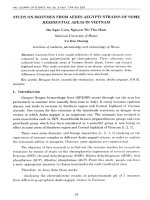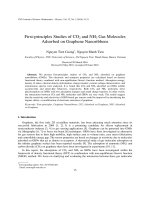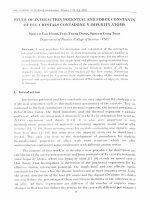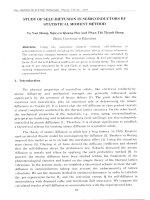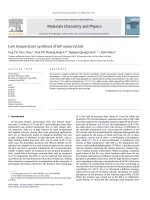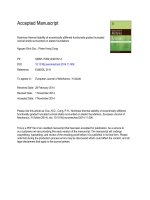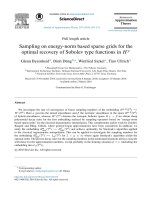DSpace at VNU: Study on synthesis of Ni xZn 1-xAl 2O4 γ-Al 2O3 (x=0, 0.5, 1) spinel catalysts by hydrothermal method and their catalytic activity in aromatic hydrocarbon conversion
Bạn đang xem bản rút gọn của tài liệu. Xem và tải ngay bản đầy đủ của tài liệu tại đây (1.43 MB, 4 trang )
e-Journal of Surface Science and Nanotechnology
23 June 2012
Conference - IWAMN2009 -
e-J. Surf. Sci. Nanotech. Vol. 10 (2012) 259-262
Study on Synthesis of Nix Zn1−x Al2 O4 /γ-Al2 O3 (x=0, 0.5, 1) Spinel Catalysts by
Hydrothermal Method and Their Catalytic Activity in Aromatic Hydrocarbon
Conversion∗
Nguyen Thanh Binh, Hoa Huu Thu,† Le Thanh Son, Tran Thi Nhu Mai, and Nguyen Hong Vinh
Department of Petroleum Chemistry, Faculty of Chemistry,
Hanoi University of Science, 334 Nguyen Trai, Thanh Xuan, Hanoi, Vietnam
(Received 6 December 2009; Accepted 21 December 2011; Published 23 June 2012)
The spinel oxides Nix Zn1−x Al2 O4 /γ-Al2 O3 (x = 0, 0.5, 1) were synthesized by hydrothermal method. Oxides
obtained were characterized by XRD and SEM. The XRD result showed principal spinel phase over all samples. In
addition, NiO phase appeared for two cases of x = 0.5 and 1. Using XRD results, the Rietveld Refinement method
indicated that the sample ZnAl2 O4 /γ-Al2 O3 consisted of wt 80% of ZnAl2 O4 and 20% of γ-Al2 O3 with crystal
size of 60 nm and 40 nm, respectively. This one was in accordance with SEM image which showed quite uniform
particles with the side from 50 to 80 nm. Catalytic activity was evaluated by methylation of toluene by methanol
and dehydrogenation of ethylbenzene to styrene. For methylation reaction, the results showed high selectivity in
xylene. In case of Ni0.5 Zn0.5 Al2 O4 /γ-Al2 O3 , at 400◦ C, the result showed the best toluene conversion of 25.46% and
selectivity in xylene was 88.33%. In case of ethylbenzene dehydrogenation reaction, sample ZnAl2 O4 synthesized
by coprecipitation method used as a reference catalyst. We observed, after 180 min of time reaction, a double
conversion of ethylbenzene on ZnAl2 O4 /γ-Al2 O3 in comparison with ZnAl2 O4 reference. In addition, working time
of ZnAl2 O4 /γ-Al2 O3 was longer than this one of ZnAl2 O4 reference. [DOI: 10.1380/ejssnt.2012.259]
Keywords: Nano spinel; Ethylbenzene; Dehydrogenation
I.
INTRODUCTION
Spinels are blulk catalysts that have small total surface
area [1]. But they have high thermal, hydrothermal stability, and acid, base, mechanical resistance. The most
advantage of spinels that they are able to form the solid
solution with active components can be changed easily [1].
In fact, the spinels that active components are transition
metallic oxides usually present high catalytic activity in
oxidation reactions.
Spinels were synthesized by many techniques. For example, the ancient techniques as coprecipitation of mixture of metallic ions or by solid state reaction of mixture
of metallic oxides formed spinels with large crystal size
and small total surface area [2–4]. Recently, the spinels
were synthesized by new techniques as sol-gel techniques,
hydrothemal method or decomposition of complexes as
precursors showed that obtained spinels had nano-crystal
size and large total surface area [5, 6].
We
synthesized
three
catalyst
samples
Nix Zn1−x Al2 O4 /γ-Al2 O3 (x = 0, 0.5, 1) by hydrothermal
method using active gel Al(OH)3 that obtained from
neutralization a solution of aluminum nitrate by ammoniac and acetates of bivalent metals, as Ni 2+, Zn2+ .
During the treatment in an autoclave at 250◦ C, the ions
of bivalent metals form the precursors Al–O–M (M=Ni,
Zn) after the reaction:
Al ≡ Al–O–H + M2+ + CH3 COO− ⇌
≡ Al–O–M(precursor) + CH3 COOH
ZnAl2O4
ZnAl2O4/g-Al2O3
(1)
Concurrently, in these conditions ion nitrate in solution
oxidize the acetic acid formed to help this chemical equi-
∗ This paper was presented at the International Workshop on Advanced Materials and Nanotechnology 2009 (IWAMN2009), Hanoi
University of Science, VNU, Hanoi, Vietnam, 24-25 November, 2009.
† Corresponding author:
Ni0.5Zn0.5Al2O4/g-Al2O3
Figure 1: SEM images of catalysts
The SEM images of catalysts shower particle size distribution of these catalysts was
FIG. 1: SEM images of catalysts.
g
g
g
libriumg to move to right forming precursors. When the
precursors were calcined at 600◦ C, spinel phases on γAl2 O3 was formed.
g
II.
EXPERIMENTAL
A solution of aluminum nitrate 1.5 M was neutralized
by ammonia solution to pH = 5.5-6. In the obtained
gelatinous precipitate, the zinc acetate and nickel acetate were dissolved with ratios calculated. The mixture
was stirred and treat at 250◦ C in an autoclave for 15 h.
Obtained precursors were washed with water distillated,
dried at 160◦ C for 12 h, then obtained solids were calcined at 600◦ C for 4 h to form catalysts. Used catalysts
had particle size of 0.5-1 mm.
The phase composition and the structure of the catalysts were analyzed by XRD using SIEMEN D5005
Diffractometer with Cu Kα radiation (λ = 1.5406 ˚
A).
The calculation of content of crystal phases and crystal
size by Rietveld Refinement method using Fullprof 200
and BGMN software based on RXD results of ZnAl2 O4 /γAl2 O3 sample was carried out according to Ref. [7].
The observation of the catalysts surface and estimation
particle size of catalysts were using SEM-5410LV with the
enlargement of 20000 times.
The influence of reaction temperature and catalyst
c 2012 The Surface Science Society of Japan ( />ISSN 1348-0391 ⃝
259
Nguyen, et al.
Volume 10 (2012)
Figure
Results
of calculation
content
of crystal
crystal
phase
size
of ZnAl
FIG. 2:
2: Results
of calculation
of content ofof
crystal
phase and
size of
ZnAl2 Oand
by Rietveld
Refinement
4 /γ-Alcrystal
2 O3 sample
method using Fullprof 2000 and BGMN software.
RESULTS AND DISCUSSIONS
The SEM images of catalysts were represented in Fig. 1.
The SEM images of catalysts shower particle size distribution of these catalysts was quite uniform. Estimation
of particle size in samples synthesized by hydrothermal
method from 50 nm to 80 nm. For the sample obtained by
coprecipitation, particle size was approximately 130 nm.
We have recorded XRD patterns of the catalysts.
The XRD patterns of catalysts confirmed that spinel
phases and γ-Al2 O3 phase were formed very well. For
Ni0.5 Zn0.5 Al2 O4 /γ-Al2 O3 and NiAl2 O4 / γ-Al2 O3 samples, beside spinels and γ-Al2 O3 phases, formation of NiO
phase was observed.
On XRD patterns of catalysts, an enlargement of picks
was observed. This effect was generated by small crystal
size.
The results of calculation of content of crystal phases
260
25
20
15
10
5
0
0
10
20
30
40
50
60
70
80
90
100
Content Zn (%)
tent in catalysts
at reaction
temperature
FIG. 3:reaction
Influence yield
of Zn content
in catalysts
reaction of
yield at
reaction temperature of 400◦ C.
and crystal size of ZnAl2 O4 /γ-Al2 O3 sample by Rietveld
refinement method using fullprof 2000 and BGMN software was shown in Fig. 2. The result showed that this
sample consisted of 80% of NiAl2 O4 with crystal size of
60 nm, and 20% of γ-Al2 O3 with crystal size of 40 nm.
This result was corresponding to SEM images of the catalysts.
The results of study on methylation of toluene by
methanol were shown in Figs. 3, 4 and 5. The results showed that xylene was formed with high selectivity. When increasing the reaction temperature,
the conversion of toluene increased
selectivity
Figure but
5: the
Influence
of temperature
of xylene decreased. Methylation reaction of toluene
on catalysts Ni
on Ni0.5 Zn0.5 Al2 O4 /γ-Al2 O3 showed the highest toluene
conversion of 25.46% with xylene selectivity of 88.33% at
400◦ C, a little amount of benzene and trimethylbenzene
was formed from secondary reactions.
The composition of catalysts also influenced on catYield H (%)
III.
30
Yield H(%)
composition to catalytic activity were investigated using
methylation of toluene by methanol. Reaction were carried out in a reactors of gaseous phase, reaction temperature from 290-400◦ C, volume rate of toluene of 2.5 h−1 ,
ratio of reagents of: toluene: methanol: water= 1:4:1.5,
after 30 minutes the products were taken out to analyze
by GC-MS.
The comparison of catalysts activity of ZnAl2 O4 /γAl2 O3 sample and ZnAl2 O4 sample synthesized by coprecipitation, and influence of reaction time to catalytic
activity were carried out using oxidation dehydrogenation
of ethybenzene to styrene using oxygen of air. The reaction was carried out at 450◦ C, volume rate of 1 h−1 , rate
of air flow of 10 ml/minute.
The liquid products were analyzed using GCMSHP6890 equipment with HP5 capillary column, carrious
gas of helium, MS detector, temperature of column top
was 50◦ C, temperature of column end was 270◦ C.
(J-Stage: />
e-Journal of Surface Science and Nanotechnology
Volume 10 (2012)
100
40
90
35
80
30
Conversion(%)
Selectivity S(%)
70
60
50
40
ZnAl2O4/g-Al2O3
25
20
15
ZnAl2O4
30
10
20
5
10
0
0
0
10
20
30
40
50
60
Content Ni (%)
70
80
90
100
0
20
40
60
80
100
120
140
160
180
200
Time (mins)
tent in catalysts Figure 4: Influence of Ni content in catalysts
Influence
of at
Nireaction
contenttemperature
in catalystsofreaction
temperatureFIG.
of 4:reaction
yield
400 C yield at
◦
reaction temperature of 400 C.
ence of reaction time to styrene
FIG. 6: Influence of reaction time to styrene selectivity on
catalysts ZnAl2 O4 /γ-Al2 O3 and ZnAl2 O4 .
30
100
/ -Al2O3
g
Ni0.5Zn0.5Al2O4/g-Al2O3
/ -Al2O3
20
15
ZnAl2O4/g-Al2O3
/ -Al2O3
ZnAl2O4
10
Conversion (%)
90
Conversion(%)
Yield H (%)
ZnAl2O4
95
25
85
80
ZnAl2O4/g-Al2O3
75
70
5
65
0
Temperature
200( C)
250
300
350
400
450
o
500
g
60
0
50
100
150
200
Temperature ( C)
re 5: Influence of temperature to reaction
Time (min)
Figure 5: Influence
O of
andtemperature to reaction
ence/Al
of reaction
O and time to styrene Figure 7: Influence of reaction time to
ethylbenzene conversion on catalysts
FIG. 5: Influence of temperature to reaction yield on catalysts
Ni0.5 Zn0.5 Al2 O4 /Al2 O3 and ZnAl2 O4 /Al2 O3 .
FIG. 7: Influence of reaction time to ethylbenzene conversion
on catalysts ZnAl2 O4 /γ-Al2 O3 and ZnAl2 O4 .
g
g
alytic activity. Figure 3 showed influence
of Zngcontent in g
0
secondary reactions involving cracking reaction, dealkycatalysts to reaction yield, at temperature of 400◦ C (Zn
lation conducting to form little amount of benzene, bencontent = nZn /(nZn +nNi ). A maximum yield attained on
g
zaldehyde, benzofurane as second
products observed on
Ni0.5 Zn0.5 Al2 O4 /γ-Al2 O3 catalysts at Zn content of 54%.
GCMS diagram. The cock content on ZnAl2 O4 /γ-Al2 O3
Increasing of Ni content in catalysts
effected to decrease
0
sample was of 85.8 mg/1g catalyst, on ZnAl2 Og4 sample
xylem selectivity, and increase content of secondary prodwas 57.9 mg/1g catalyst after 3 h of reaction.
ucts from parasite reaction. Figure 4 showed influence of
Ni content in catalysts on selectivity of xylene, at temperature of 400◦ C. The results showed that when the absence
g
IV. CONCLUSION
of water in the first material, the conversion of toluene was
very low, about 8.14% on Ni0.5 Zn0.5 Al2 O4 /γ-Al2 O3 cataThe catalysts of spinels on gamma aluminium oxide
lysts at 400◦ C. This permitted to predict that alkylation
of toluene was mainly catalyzed by OH groups link with - Nix Zn1−x Al2 O4 /γ-Al2 O3 (x = 0, 0.5, 1) were synthemetal ion as Bronsted acid centers that the water had the sized using hydrothermal method. XRD patterns of catalysts confirmed that spinel phases and gγ-Al2 O3 phase
role to form them.
The results of study on oxidative dehydrogenation of were formed very well.
g 7.
Calculation of content of crystal phases and crystal size
ethylbenzene to styrene were represented in Figs 6 and
The results showed that styrene selectivity was very high by Rietveld Refinement method using Fullprof 2000 and
on both of two samples. The ethylbenzene conversion on BGMN software based on XRD results of ZnAl2 O4 /γZnAl2 O4 /γ-Al2 O3 sample was about two times more than Al2 O3 sample showed that this sample consisted of 80%
on ZnAl2 O4 sample synthesized by coprecipitation after of ZnAl2 O4 with crystal size of 60 nm, and 20% of γreact time of 180 minutes. This can be explained by small Al2 O3 with crystal size of 40 nm. These results were
crystal size and large total surface area of ZnAl2 O4 /γ- corresponding with SEM images.
Al2 O3 sample.
For methylation of toluene by methanol on catalysts,
The catalytic activity decreased slowly according to xylene was formed with high selectivity. Ni content in
the reaction time. ZnAl2 O4 /γ-Al2 O3 sample contained catalysts influenced to toluene conversion and xylene seAl2 O3 as solid acid and it had porous structure effected lectivity.
(J-Stage: />
261
Nguyen, et al.
Volume 10 (2012)
For oxidation dehydrogenation of ethylbenzene to
styrene, ZnAl2 O4 /γ-Al2 O3 sample was better than
ZnAl2 O4 sample synthesized by coprecipitation with
higher catalytic activity and longer life time.
These results contributed to study to synthesize and
catalytic activity of nanostructure materials.
[1] P. V. Tuong, Inorganic Materials (Editor of Vietnam National University in Hanoi, Hanoi, 2002).
[2] B. Gillot, A. Ruosset and G. Dupre, Solid State Chem. 25,
263 (1978).
[3] M. Bremer, S. Fischer, and N. Langbein, Thermochimica
Acta 209, 323 (1992).
[4] J. I. Dicosimo, J. Catal. 178, 499 (1998).
262
Acknowledgments
The authors gratefully acknowledge financial support
from the National Foundation for Science and Technology
Development of Vietnam (NAFOSTED).
[5] H. Heegn, J. Cryst. Res. Technol. 35, 255 (2000).
[6] Y. Xie, J. Mater. B 34, L1 (1995).
[7] J. Rodriguez-Carvajal, An Introduction to the Program
FULLPROF 2000 (Laboratoire Leon Brillouin (CEA CNRS), France, 2001).
(J-Stage: />

